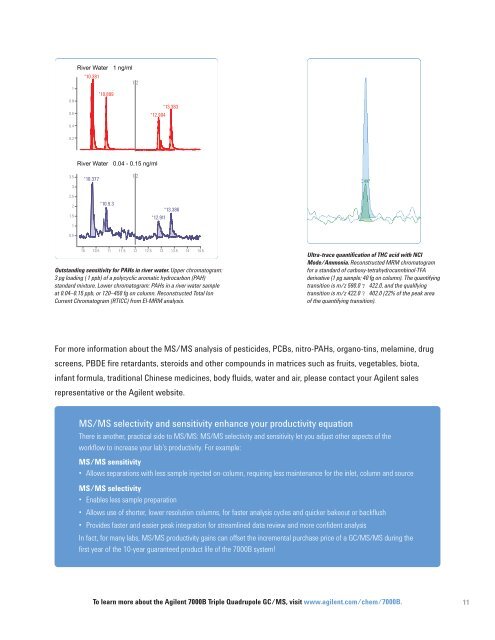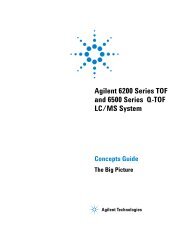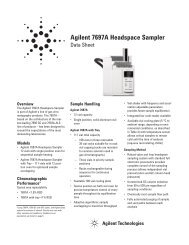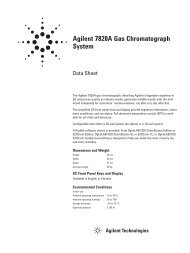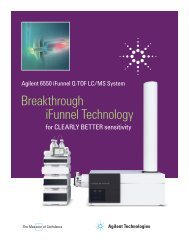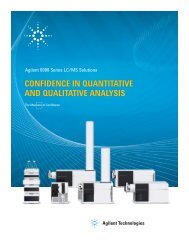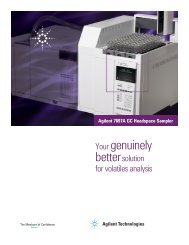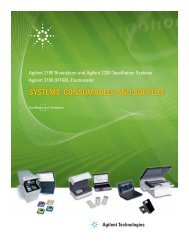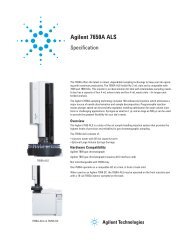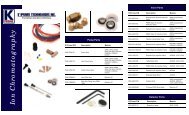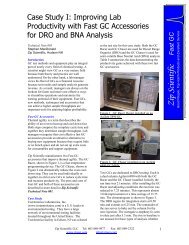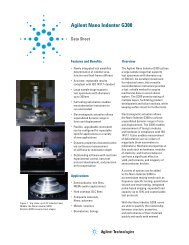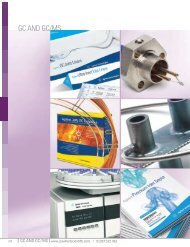Agilent 7000B Triple Quadrupole GC/MS - K'(Prime) Technologies
Agilent 7000B Triple Quadrupole GC/MS - K'(Prime) Technologies
Agilent 7000B Triple Quadrupole GC/MS - K'(Prime) Technologies
Create successful ePaper yourself
Turn your PDF publications into a flip-book with our unique Google optimized e-Paper software.
River Water 1 ng/ml<br />
*10.381<br />
1 2<br />
1<br />
*10.899<br />
0.8<br />
0.6<br />
*12.904<br />
*13.383<br />
0.4<br />
0.2<br />
River Water 0.04 - 0.15 ng/ml<br />
3.5<br />
3<br />
*10.377<br />
1 2<br />
2.5<br />
2<br />
1.5<br />
1<br />
0.5<br />
*10.9.3<br />
*13.386<br />
*12.911<br />
10<br />
10.5 11 11.5 12 12.5 13 13.5 14 14.5<br />
Outstanding sensitivity for PAHs in river water. Upper chromatogram:<br />
3 pg loading ( 1 ppb) of a polycyclic aromatic hydrocarbon (PAH)<br />
standard mixture. Lower chromatogram: PAHs in a river water sample<br />
at 0.04–0.15 ppb, or 120–450 fg on column. Reconstructed Total Ion<br />
Current Chromatogram (RTICC) from EI-MRM analysis.<br />
Ultra-trace quantification of THC acid with NCI<br />
Mode/Ammonia. Reconstructed MRM chromatogram<br />
for a standard of carboxy-tetrahydrocannbinol-TFA<br />
derivative (1 pg sample; 40 fg on column). The quantifying<br />
transition is m/z 590.0 422.0, and the qualifying<br />
transition is m/z 422.0 402.0 (22% of the peak area<br />
of the quantifying transition).<br />
For more information about the <strong>MS</strong>/<strong>MS</strong> analysis of pesticides, PCBs, nitro-PAHs, organo-tins, melamine, drug<br />
screens, PBDE fire retardants, steroids and other compounds in matrices such as fruits, vegetables, biota,<br />
infant formula, traditional Chinese medicines, body fluids, water and air, please contact your <strong>Agilent</strong> sales<br />
representative or the <strong>Agilent</strong> website.<br />
<strong>MS</strong>/<strong>MS</strong> selectivity and sensitivity enhance your productivity equation<br />
There is another, practical side to <strong>MS</strong>/<strong>MS</strong>: <strong>MS</strong>/<strong>MS</strong> selectivity and sensitivity let you adjust other aspects of the<br />
workflow to increase your lab’s productivity. For example:<br />
<strong>MS</strong>/<strong>MS</strong> sensitivity<br />
• Allows separations with less sample injected on-column, requiring less maintenance for the inlet, column and source<br />
<strong>MS</strong>/<strong>MS</strong> selectivity<br />
• Enables less sample preparation<br />
• Allows use of shorter, lower resolution columns, for faster analysis cycles and quicker bakeout or backflush<br />
• Provides faster and easier peak integration for streamlined data review and more confident analysis<br />
In fact, for many labs, <strong>MS</strong>/<strong>MS</strong> productivity gains can offset the incremental purchase price of a <strong>GC</strong>/<strong>MS</strong>/<strong>MS</strong> during the<br />
first year of the 10-year guaranteed product life of the <strong>7000B</strong> system!<br />
To learn more about the <strong>Agilent</strong> <strong>7000B</strong> <strong>Triple</strong> <strong>Quadrupole</strong> <strong>GC</strong>/<strong>MS</strong>, visit www.agilent.com/chem/<strong>7000B</strong>.<br />
11


